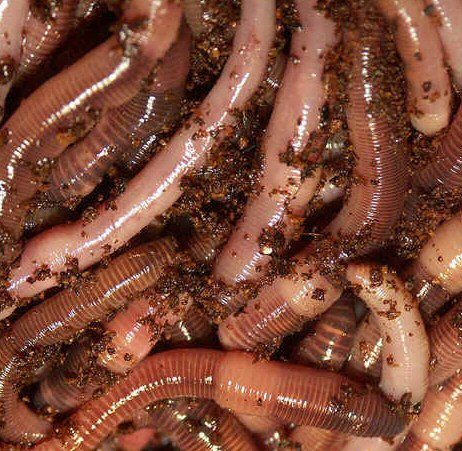Raising European Nightcrawlers
European Nightcrawlers (Eisenia hortensis) are also known as the Belgian Worm, Super Red, Carolina Crawlers and Blue Worms. The most fitting name is "Giant Redworm".European Nightcrawlers grow to be 3-8 inches long, and are 2 or 3 times bigger than their smaller cousins, the red wigglers. When they are not stretched out, they are as thick as a pencil.

The ideal temperature for most worms is between 55 and 78 degrees Fahrenheit. European Nightcrawlers can stand temperatures as low as 45 degrees F. Ideal growth is achieved between 60° and 70° F.
Peat moss and coconut coir are perfect for bedding. The European Nightcrawler prefers bedding that is moist but not wet. If you squeeze a handful of the bedding you should produce only a couple of drops. If the substrate is to wet, European Nightcrawlers will try to escape.The bedding should be about 6-8" deep. European Nightcrawlers eat a diet rich in garbage and are great for composting kitchen scraps.
Many feed European Nightcrawlers chicken egg laying mash to ensure proper calcium levels. I prefer to feed calcium rich greens and the powders offered here. Feed the European Nightcrawlers on one side of the bin only. You will always want to give the worms some room to escape should the bedding become sour. It is important to top feed these worms so that the feed does not get mixed into the bedding. Proper Ph in the beds critical. It is best to keep the pH of your worm bedding between 6.0 and 7.0. To monitor the pH you will need a decent pH meter, or a chemical pH tester that most garden centers carry. If the pH becomes too acidic you can raise it with calcium carbonate (agricultural lime or powdered limestone ). It is a good idea to sprinkle the bedding with powdered limestone every few weeks. This will help maintain the proper pH and increase the calcium content of the worms.
You can create a bin out of anything that will hold bedding, and allow for drainage. Tubs, Rubbermaid containers, wooden crates, or cement block beds all make great housing for Europeans. Just be sure to turn the bedding in whichever container you use every three weeks. Turning the bedding gives you a chance to see the European Nightcrawlers, but is also provides air to the bedding, which will help reduce harmful acid from being produced.
European Nightcrawlers (Eisenia hortensis) are prolific breeders. Not long after setting up your bin you will see many egg capsules. The European Nightcrawlers will lay eggs near where the food is placed.

